BIO 123 | History & Scope of Microbial Ecology
1/152
There's no tags or description
Looks like no tags are added yet.
Name | Mastery | Learn | Test | Matching | Spaced |
|---|
No study sessions yet.
153 Terms
Microbial Ecology vs. Environmental Microbiology
Microbial ecology
Addressed the interactions between microbes and between microorganisms and higher forms of life
Singvhi et al. (2020): Interplay of human gut microbiome in health & wellness
There are microorganisms inside our body that influences human health
Environmental microbiology
Study of processes in the environment mediated by microorganisms
Harms et al. (2011): Exploiting fungi for bioremediation of hazardous chemicals
Microorganisms influence the environmental processes occurring in aquatic, semiaquatic, & riparian habitats
T/F: There are subtle differences between environmental microbiology and microbial ecology but huge overlaps.
TRUE
Origin & Evolution of Microorganisms | Key idea
Microbes have developed mechanisms that allowed for their great ubiquity.
THEME 1 | Origin & Evolution of Microorganisms
Explain 4 mechanisms of bacteria that allowed for their great ubiquity
sdfs
Short life cycles with high mutation rates
Short life cycles would mean higher reproductive rates > rapid reproduction process, probably due to being able to reproduce asexually
High mutation rates increase their probability of acquiring a mutation that may confer favorable traits amongst their population and in their environment
Diverse metabolic plasticity
Unlike humans who rely on cellular respiration for powering metabolic processes, bacteria have super diverse metabolisms, e.g., fermentation, anaerobic respiration, chemolithotrophy, photoautotrophy, etc.
Diversity and frequency of genetic transfer
Diverse genetic transfer modes, such as
Transformation: uptake of naked DNA from environment
Transduction: transfer of genetic material via bacteriophages
Conjugation: transfer of genetic material via direct contact
that, in turn, allows them to have higher or more frequent rates of genetic transfer:
which would also imply a higher probability of developing mutations that confer beneficial traits to a population, an example of which are:
Stress + resistance strategies
Methicilin-resistant Staphylococcus aureus (MRSA)
Prime example of how bacteria can acquire resistance via HGT
What allowed these strains to be MR is their acquiring of a mecA gene, which encodes an altered penicillin-binding protein (PBP2a) with low affinity to B-lactam antibiotics, e.g., methicilin.
Due to this low affinity of B-lactam antibiotics to PBP, it fails to inhibit the crosslinking of peptidoglycans for bacterial cell wall by the PBP. Thus, PBP can continue its cell wall synthesis function and the bacteria is able to resist methicilin.
T/F: Only prokaryotes are capable of horizontal gene transfer (HGT).
FALSE
While HGT is more common in prokaryotes, certain eukaryotes, such as fungi, plants, and even animals, can acquire genes from other organisms through mechanisms like viral infections, endosymbiosis, or direct transfer from other species. For example, parasitic plants can obtain genes from their host plants, and some eukaryotes acquire genes from bacteria, which can provide new functions.
T/F: Microbes have been adapting to climatic and geological changes that have occurred on Earth since the beginning of life, permeating equable habitats.
FALSE
Permeating varied habitats
T/F: All prokaryotes are unicellular.
TRUE
Biofilms, myxobacteria, and filamentous cyanobacteria, exhibit multicellular-like behavior or organized communities, but they are not technically multicellular in the same way that eukaryotic multicellular organisms are.
Taxonomic and Functional Diversity | Key idea
Microbes have a huge taxonomic and functional diversity in varied ecosystems.
THEME 2 | Taxonomic and Functional Diversity
Explain the huge taxonomic and functional diversity of microbes in varied ecosystems.
Larsen et al. (2017)
All prokaryotic and eukaryotic unicellular microorganisms, even virus, are in the functional dimension of microbial ecology.
Systematics of microorganisms is rapidly changing.
Wilson et al. 1992: Animals are dominant in diversity and numbers (dominant blue in pie chart)
Mora et al. 2011: With inclusion of invertebrates in Kingdom Animalia, the blue portion became more dominant.
Larson et al. 2017: With the discovery of more sophisticated techniques and shifting of analysis from phenotypes to genotypes, they discovered that microbes comprise 78% of diversity and density of all living organisms.
Excluding Archaea, which if added could easily double/rival that 78%
Excluding viruses, as these are not living things
In terms of sheer number, virus > bacteria > humans
Raoult and Forterre (2008)
Proposed dividing biological entities into
Ribosome-encoding organisms (REO)
Bacteria, Archaea, Eukarya
Encodes their own ribosomes, machinery for protein synthesis
Capsid-encoding organisms (CEO)
Viruses of B,A,E
Can’t encode ribosomes, only have capsids (protein coats), must hijack host cell to replicate and metabolize
T/F: Viruses can encode their own ribosomes.
FALSE
They are CEOs and often considered "biological entities" rather than living organisms because they lack the essential machinery (ribosomes) for autonomous life. They cannot carry out metabolic processes or replicate on their own and must hijack a host cell’s machinery to reproduce.
Roles in Ecosystem Functioning | Key idea
Microbes play major roles in the organization, functioning, and evolution of ecosystems.
Ecosystem functioning vs. Ecosystem services
Ecosystem functioning refers to mechanisms and processes that sustain life in an ecosystem.
Ecosystem services refers to the benefits derived by humans from an ecosystem.
THEME 4 | Roles in Ecosystem Functioning
Explain the microbes’ role in ecosystem functioning (4).
Microbial mass, metabolic diversity, and ecological adaptability allow microbes to:
Participate and control food web and trophic interactions
In oceans, microorganisms drive food webs. They are the main producers.
They influence food web dynamics by making nutrients available to other organisms.
Perform organic and mineral transformations
Decomposing organic matter
Can perform photosynthesis to convert CO2 into organic matter
Nutrient cycling, especially nitrogen
Nitrogen is limiting in many environments (and even us humans need it for nucleic acids, proteins)
Humans can’t fix nitrogen, but microbes can (lightning also can).
Run biogeochemical cycles and systems
Carbon cycle
Decomposing organic matter
Photoautotrophy
Nitrogen cycle
Nitrogen-fixing bacteria can convert atmospheric nitrogen into forms usable by plants.
Carry out synthesis and degradation reactions
Mercury is highly volatile in air and when it gets deposited into bodies of water, it may be absorbed by tissues of fish and accumulate in their bodies.
Bacteria can methylate mercury, producing methylmercury, which is a toxic and bioaccumulative form that can potentially pose threats to human and animal health.
Bacteria can also degrade/demethylate mercury, mitigating its impact
Some bacteria can also easily degrade oil spills
Bioremediation
Decomposition
T/F: Microorganisms participate in cloud formation.
TRUE
For clouds to form, water vapor in atmosphere must condense into tiny water droplets. For these to condense, water vapor requires a surface to which it can adhere to called nucleation sites.
Microorganisms release organic compounds, e.g., proteins and polysaccharides, which can serve as nucleation sites for droplets.
Nitrogen-fixing bacteria influence formation of aerosols, which may also serve as nucleation sites.
Biotic Interactions | Key idea
Microorganisms interact with other microbes and all the other multicellular living organisms.
THEME 4 | Biotic interactions
Explain population dynamics, symbioses, and pathogenicity.
Population dynamics
Populations of different microbes in various environments can form biofilms and microbial mats that provides these microbes greater access to nutrients and protection from predation and physicochemical disturbances.
Symbioses
Mutualism
Cows and microbes
In cows, a symbiotic relationship with microorganisms allow these ruminants to digest a diet rich in fiber and low in protein (cellulose). Their rumen, in turn, provides a safe, substrate-rich environment for these microbes to proliferate.
Squids and microbes
Bacteria provides squids the light to help them camouflage, while squids provide bacteria with nutrients and protection (a safe habitat).
Fungi and trees
Ecto- and endomycorrhizae
Fungi (mycorrhizae) extends roots of tree/plant, allowing for more efficient water and nutrient uptake
Plant/tree, in turn, provides fungi with organic compounds
Pathogenicity
Certain interactions between microorganisms and living organisms result in diseases (including crop and animal).
Diarrheal diseases is second leading cause of death in children under 5yo and is responsible for deaths of 370,000 children in 2019 (WHO 2020).
Abiotic Interactions | Key idea
Differences in physical and chemical aspects of an environment affects microbes.
THEME 5 | Abiotic interactions
Explain presence/absence, spatial distribution, and growth & activity.
Presence/absence
Most important environmental parameters interacting with microorganisms:
pH
pressure (temperature)
light intensity and wavelength
electron donor and acceptor concentration
Spatial distribution
Interaction of microorganisms with natural surfaces must be considered because many of these microbes are not free-living in nature and attach to surfaces.
Growth & activity
In natural systems, resources are limited and do not allow maximal growth and development of microbes, prompting their evolution of myriad survival mechanisms.
T/F: In natural systems, resources are infinite and allow maximal growth and development of microbes
FALSE
Resources are limited
Bioremediation & Other Activities | Key idea
Microbial ecology can provide solutions to many environmental problems.
THEME 6 | Bioremediation and other activities
Explain major drivers of global habitat degradation
Major Drivers of Global Habitat Degradation
isi
Increase of world population
Settlement of populations over extended range of biotopes
Industrial development and production of more and more domestic and industrial wastes
How do we enhance metabolic properties of microorganisms to degrade most pollutants that affect our planet?
Bioremediation (there are microorganisms that accelerate degradation of oil spills, heavy metals, plastics, etc.)
How do we enhance metabolic properties of microorganisms to degrade most pollutants that affect our planet?
Bioremediation
Public Health Issues | Key idea
Microbial ecology can help in understanding public health issues from a broader view.
THEME 7 | Public Health Issues
Explain 3 public health problems
pfc
Production of safe drinking water and water resources
Food contamination and food safety
Changes in behavior of pathogens in environment
T/F: Microbiology existed before the invention of microscopes.
FALSE
Microbiology only existed after the invention of the microscope.
*Hans and Zacharias Janssen created the first microscope.
Who made the first known description of microorganisms?
English mathematician and natural historian, Robert Hooke
In Hooke’s book Micrographia, he illustrated many microscopic images, including _
fruiting structures of a mold using a compound microscope
Who is the first person to see bacteria in pepper-water using hand lens?
Dutch draper and amateur microscopist Antoni van Leeuwenhoek
_ constructed a simple microscope containing single lens (266x magnification) to examine various natural substances for microorganisms.
He wrote to Royal Society of London who made an English translation of his works. He observed '“animalcules” from sampling a drunk man’s teeth.
Antoni van Leeuwenhoek
Ridiculed rival of Leeuwenhoek, pioneer of protistology
Louis Joblot
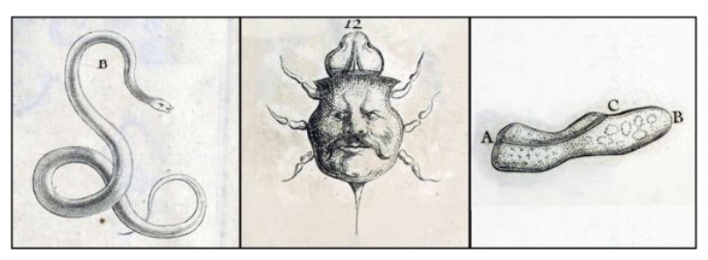
_ was ridiculed for his imaginative portrayal of microscopic protists in his drawings
Louis Joblot
*Paramecium = 3rd photo from left
_ devoted much of his time to develop microscopes with which he described animalcules and other microscopic “snakes, fish, and eels,” which he observed in infused preparations of various plants or vinegar, and “the largest part is invisible to the ordinary scope of our eyes.”
Louis Joblot
He is the pioneer of the theory of microbial diseases
Ignaz Semmelweis
Ignaz Semmelweis imposed a new rule mandating handwashing with chlorine for doctors. This resulted in _
The rate of deaths in his maternity ward dramatically declining—the first proof that cleansing hands could help prevent infection and death from puerperal fever.
_ studied fermentation, sterilization, disease and vaccination
Louis Pasteur
Louis Pasteur successfully disproved spontaneous generation in 1859 by showing _
The mechanics of spoilage with his swan-necked flasks, which showed that “vital essence” in their air did not cause putrefaction.
2 flasks (1 control, 1 experimental) with sterilized NB
Exposed to open air
For experimental, there was no microbial growth since while swan-neck design allowed entry of air, it prevented dust particles and microorganisms from reaching the NB
For control, after breaking the swan-neck design, microbial growth was immediately observed, indicating that microorganisms from the air were responsible for the contamination
_ and his colleagues discovered that the rabies virus could be weakened or attenuated by drying the spinal cords of infected rabbits. This weakened virus was used to create a vaccine.
Pasteur
_ established postulates that would solidify the germ theory of diseases
Robert Koch
Koch’s 4 Postulates
The suspected pathogen must be present in all cases of disease and absent from healthy animals.
The disease organism must be isolated in pure culture.
Inoculation of sample of culture into a healthy, susceptible animal must produce the same disease.
The disease organism must now be recovered from the newly inoculated animal.
bacteriocins vs. antibiotics
While both serve to inhibit bacterial growth,
Bacteriocins are naturally produced by bacteria, have narrow spectrum of activity, making it less likely to induce resistance
Antibiotics can be naturally or synthetically produced and have wider spectrum of activity, but their overuse can lead to resistance
The first to observe interactions between microorganisms and develop antibiotics
Sir Alexander Fleming
In 1959, Fleming observed the inhibition of a culture of _ by contaminating mold, _.
Staphylococcus
Penicilium notatum
Fleming’s discovery of antibiotics allowed us to think that _
There are other ways microbes can be killed
Bacteria can produce substances that kill other bacteria
The discovery of _ opened up a world smaller than bacteria and fungi
Viruses
_ was the first to demonstrate unfilterable infectious particles smaller than bacteria while studying tobacco mosaic virus (TMV)
Sergei Ivanovski
_ discovered the first oncovirus (1911), Rous Sarcoma Virus (RSV), which caused tumors in chickens
Peyton Rous
_ described bacteriophages, could not be observed until the discovery of electron microscope in 1939.
Felix Hubert d’Herelle
An area of uniform environmental conditions providing living space for a specific assemblage of plants and animals
Biotope
_ was the first to describe the “microbiology of natural biotopes”
Sergei Winogradsky
Winogradsky described 8 microorganisms using his Winogradsky column, which did not use a pure-culture strategy.
Purple photosynthetic bacteria
Sulfur-producing bacteria
Anoxygenic phototrophic bacteria
Sulfur-reducing bacteria
Iron-oxiding bacteria
Nitrifying bacteria
Denitrifying bacteria
Nitrogen-fixing bacteria
Nitrifying vs. Nitrogen-fixing vs. Denitrifying
Nitrifying bacteria converts ammonia > nitrite > nitrate
Nitrogen-fixing bacteria converts atmospheric nitrogen > ammonia (form usable by plants)
Denitrifying bacteria converts nitrate/nitrate > nitrogen gas/nitrous oxide
T/F: Winogradsky’s experiment involved the use of a pure-culture strategy
FALSE
Sergei Winogradsky was the first to demonstrate the fundamental role of microbes in the _
transformation of mineral compounds through various metabolic processes and that allowed him to simultaneously grow different communities of bacteria along gradients of sulfur, light, O2.
T/F: In Winogradsky column, oxygen levels are highest at the surface and decrease toward the bottom of the column.
TRUE
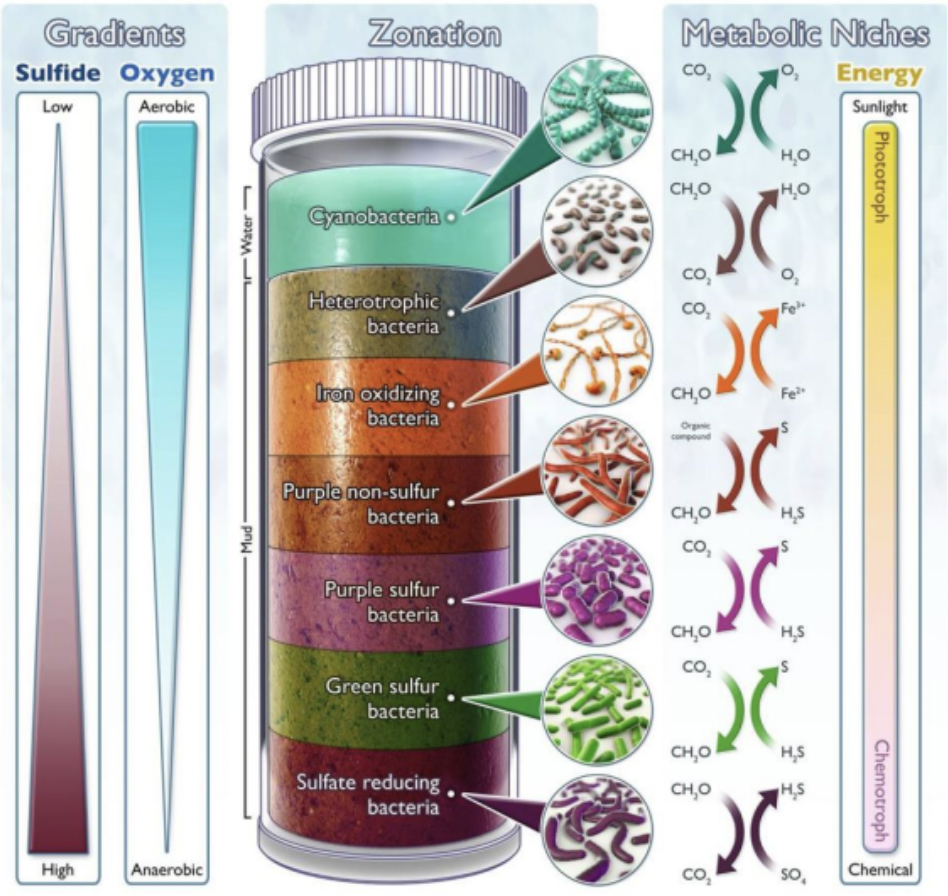
T/F: Hydrogen sulfide concentrations are highest at the top of the column, where sulfate-reducing bacteria thrive, and decrease toward the bottom.
FALSE
Hydrogen sulfide concentrations are highest at the bottom of the column, where sulfate-reducing bacteria thrive, and decrease toward the top.
T/F: Winogradsky provided the framework for studying microbial ecology, specifically Monograph: Soil Microbiology: Problems & Methods
TRUE
Explain Monograph: Soil Microbiology: Problems & Methods
The study of pure cultures, while favorable bc it allows us to determine the microbes’ metabolic properties and mechanisms, does not mirror natural microbial life in the environment.
The diversity of microorganisms is profound and very few are culturable in lab conditions.
What we currently know as diversity of microorganisms is just the culturable ones
Not all microorganisms are in an active state, which reflects their resistance to adverse conditions.
A technique used to increase the relative abundance of a specific microorganism in sample to make it easier to isolate and study them
Enrichment technique
Enrichment technique vs. culture method
Enrichment technique: used when target microorganism is difficult to isolate directly due to low abundance or specific growth requirements.
Culture method: used broadly to isolate, grow, and study microorganisms from various samples.
_ has contributed greatly to our understanding of biogeochemical cycles and microbial transformations on a global scale
Martinus Beijerinck
He was the first to describe viruses as reproducing entities different from other organisms
Beijerinck
He described biological nitrogen fixation
Beijerinck
_ showed the significant role of microorganisms in the recycling of elements and balance of ecosystems necessary for the maintenance of environmental quality and maintenance of life on Earth by _
Beijerinck
Developing enrichment techniques and culture methods
Microbial Ecology in the Present Time | Key idea
Unexplored aspects of microbial life, interactions, and metabolic activities are being shed light through technological advancements and contemporary discoveries.
Technological advancements and contemporary discoveries in modern microbial ecology
Environmental metagenomics
Study genetic material recovered directly from environmental samples, without needing to culture organisms.
Sequence everything from the sample and process it thru high throughput sequencing technologies (bioinformatics)
Scientists can now explore questions related to:
extent of diversity within naturally occurring microbial communities, and
functional significance of that diversity
Taxonomic composition bar plot illustrating phylum-level composition of microbial-mat samples
Biocomplexity
Studies interactions among microbes and between microbes and their environment, emphasizing a whole ecosystem, rather than its parts, seeking to identify emergent properties that cannot be found in studies of individual components.
Principal Coordinate Analysis plot containing 37,680 samples
Antibacterial substance secreted by bacteria
Bacteriocin
e.g., of emergent properties in bacteria
Biofilm formation
Quorum sensing
Swarming motility
Which subdivision of microbio does microbial ecology fall under?
Basic research microbio > by process
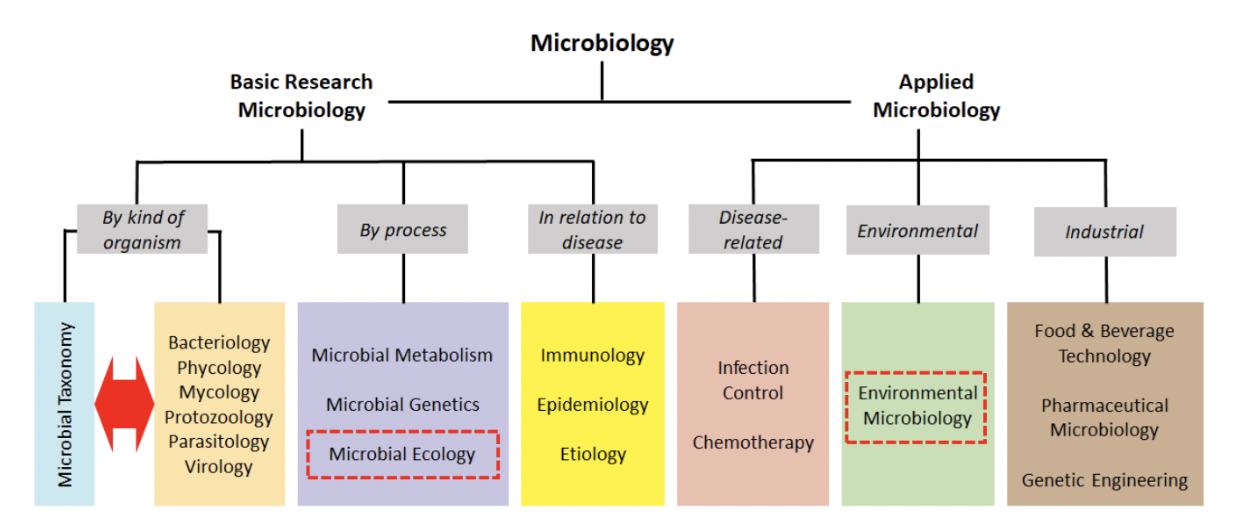
Which subdivision of microbio does environmental microbio fall under?
Applied microbio > environmental
Study & Scope of Modern Microbial Ecology | Key idea
Pasteur, Koch, and other early microbiologists were generalists. Developments in S&T allowed more specialized fields to be developed, including microbial ecology.
Understanding the development of microbial ecology entails _
understanding the timeline of Earth’s development and how microbes evolved with it
Sum of chemical processes carried out by living organisms necessary to maintain life
Metabolism
Many molecules constituting cellular structures and energy used to power reactions are obtained via _
Metabolism
Type of metabolism that involves breaking down of larger molecules that, in turn, releases useful form of energy + lost heat, and produces small molecules
Catabolism
Type of metabolism that creates larger molecules from smaller precursor molecules by using energy
Anabolism
Volume of bacterial cell, percent compostion
2×10^-12 cm³
70% H2O
30% chemical — macromolecules
15% proteins, 6% RNA, 2% polysaccharide, 1 % DNA
Electron transfers that allow some energy to be captured and stored for cell use
Redox reactions
(+)
Loss of electrons
Loss of hydrogen
Loss of energy
Gain of oxygen
Exothermic, exergonic
Oxidation
(-)
Gain of electrons
Gain of hydrogen
Gain of energy
Loss of oxygen
Endothermic, endergonic
Reduction
arrange in increasing oxidation potential
formic acid, methanol, carbon dioxide, formaldehyde, methane
carbon dioxide < formic acid < formaldehyde < methanol < methane
methane has the highest oxidation potential bc it has the highest potential to lose high number of hydrogen/electrons (currently in low oxidation state)

arrange in increasing oxidation state
formic acid, methanol, carbon dioxide, formaldehyde, methane
methane (-4) < methanol (-2)< formaldehyde (0) < formic acid (+2) < carbon dioxide (+4)
CO2 has the highest oxidation state because it has lost the most electrons.
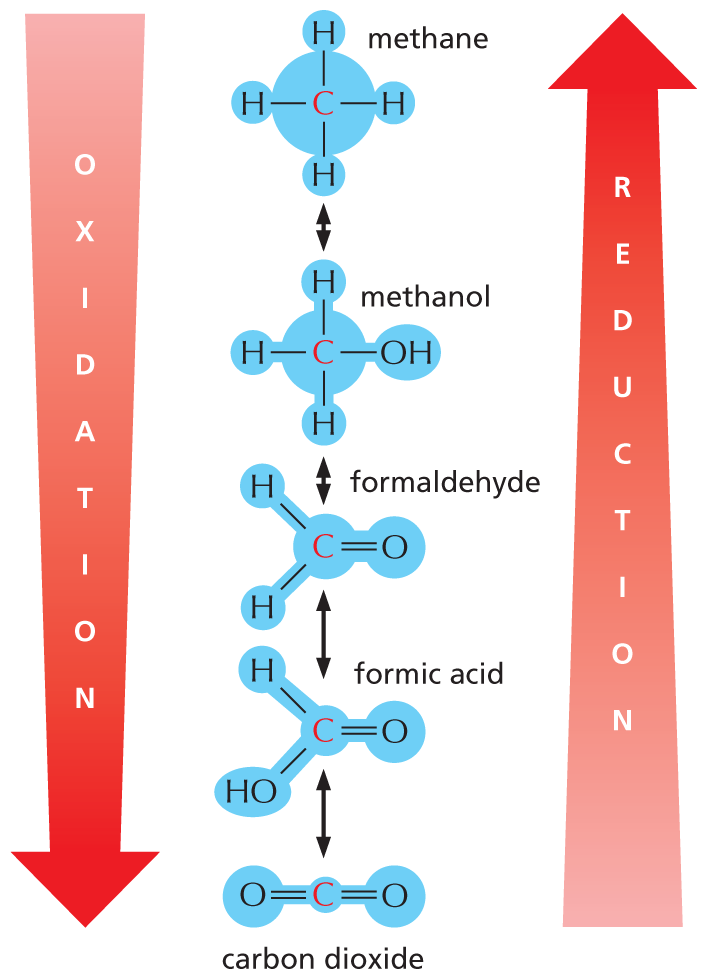
arrange in increasing reduction potential
formic acid, methanol, carbon dioxide, formaldehyde, methane
methane < methanol < formaldehyde < formic acid < carbon dioxide
Carbon dioxide has highest reduction potential bc it has highest potential to gain hydrogen/electrons
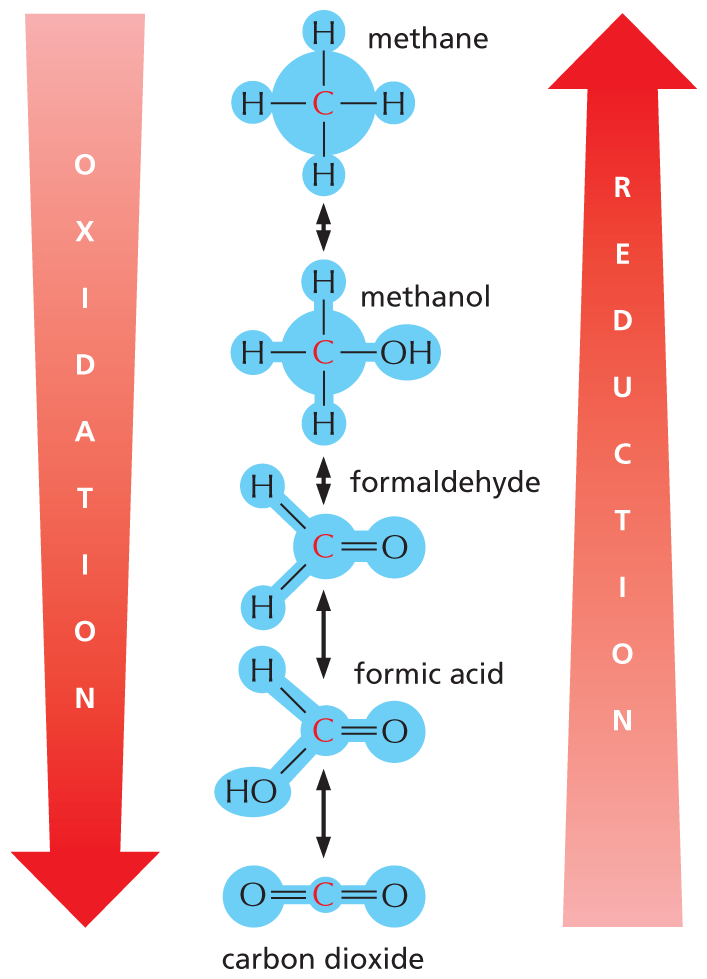
arrange in increasing reduction state
formic acid, methanol, carbon dioxide, formaldehyde, methane
carbon dioxide < formic acid < formaldehyde < methanol < methane
Methane has highest reduction state because it is highly reduced, i.e., gained most hydrogen/electrons

reduced or oxidized?
NADH
Reduced
reduced or oxidized?
NAD+
Oxidized
reduced or oxidized?
FAD
Oxidized
reduced or oxidized?
FADH2
Reduced
3 activated energy carriers during Krebs
NADPH
NADH
FADH2
A reducing agent reduces an entity by _
oxidizing itself (undergoing oxidation)
RA loses electron for the other entity to gain it or become reduced.
LEORA: Reducing agent loses electrons (undergoes oxidation)
An oxidizing agent induces oxidation by _
reducing itself (undergoing reduction)
OA oxidizes entity by gaining/hogging its electrons to themselves
GEROA: Oxidizing agent gains electrons
Oxidizing agent for catabolism
NAD+
Reducing agent for anabolism
NADPH
T/F: The evolution of microbial life is tied to the development of the Earth. Anabolic and catabolic pathways were patterned on the available molecules present.
TRUE
Arrange ff. in sequence (how they appeared on earth)
vascular plants, eukarya, animals, mammals, cyanobacteria, phototrophic bacteria, bacteria & archaea, humans
Bacteria & Archaea (3.9 bya)
Phototrophic bacteria (No oxygen)
Cyanobacteria (Oxygenated atmosphere)
Eukarya (Oxygen present onwards)
Animals
Vascular plants
mammals
Humans
Earth dates back to _
4.6 bya
Type of photosynthesis that uses alternative electron donors, e.g., hydrogen sulfide (H2S), instead of H2O and bc there’s no splitting of water, there’s also no production of oxygen.
Anoxygenic photosynthesis
_ focuses on material production, which requires carbon/nitrogen source to occur.
Anabolism
_ metabolism involves synthesizing cellular materials from precursor molecules
Anabolic
Cellular materials produced from anabolism are used for _
Growth
Reproduction
Repair of cellular structures
_ focused on energy production, which requires energy source to occur.
Catabolism